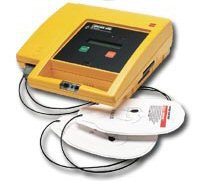|
Menu
Home
News
AEDs
AED Software
PAD Programs
PAD Software
Screen Shots
Docs
Links
Downloads




The OpenISES Project
|
What Are AEDs?
 An Automated External Defibrillator (AED) is a device that
attaches to the victims chest and looks at the persons heart
rhythm. It then has the ability to determine if the heart needs
to be shocked, and if so, delivers that shock to correct the
rhythm. An adult that has collapsed from sudden cardiac arrest
(cessation of a heartbeat) is most likely in need of the
defibrillatory shock that can be delivered by an AED.
An Automated External Defibrillator (AED) is a device that
attaches to the victims chest and looks at the persons heart
rhythm. It then has the ability to determine if the heart needs
to be shocked, and if so, delivers that shock to correct the
rhythm. An adult that has collapsed from sudden cardiac arrest
(cessation of a heartbeat) is most likely in need of the
defibrillatory shock that can be delivered by an AED.
AEDs are the public accessible version of the defibrillation
paddles used in hospital emergency rooms and ambulances. The
AEDs have the ability to analyze the heart rhythms on its own,
and determine if an electrical shock would be appropriate. It
then charges itself and delivers the shock. This automatic
feature is what allows the general public to perform this skill.
 Currently, the American Heart Association estimates that at
least 250,000 lives are lost to sudden cardiac arrest every
year, and currently, only 5-10% of these victims survive. We
also know that CPR alone is not enough. Doctors have known for
years that rapid defibrillation (within 3-5 minutes) was key to
improving survival rates from sudden cardiac death. Only
recently has computer technology allowed a machine to determine
the EKG, thereby removing the need to have a person trained in
EKGs being the only one able to deliver this life saving
technique. It is estimated that 40,000 lives could be saved
annually if more communities deployed AEDs.
Currently, the American Heart Association estimates that at
least 250,000 lives are lost to sudden cardiac arrest every
year, and currently, only 5-10% of these victims survive. We
also know that CPR alone is not enough. Doctors have known for
years that rapid defibrillation (within 3-5 minutes) was key to
improving survival rates from sudden cardiac death. Only
recently has computer technology allowed a machine to determine
the EKG, thereby removing the need to have a person trained in
EKGs being the only one able to deliver this life saving
technique. It is estimated that 40,000 lives could be saved
annually if more communities deployed AEDs.
Subscribe to our e-mail list
https://lists.sourceforge.net/mailman/listinfo/pad-prg-mgt-news
|


 An Automated External Defibrillator (AED) is a device that
attaches to the victims chest and looks at the persons heart
rhythm. It then has the ability to determine if the heart needs
to be shocked, and if so, delivers that shock to correct the
rhythm. An adult that has collapsed from sudden cardiac arrest
(cessation of a heartbeat) is most likely in need of the
defibrillatory shock that can be delivered by an AED.
An Automated External Defibrillator (AED) is a device that
attaches to the victims chest and looks at the persons heart
rhythm. It then has the ability to determine if the heart needs
to be shocked, and if so, delivers that shock to correct the
rhythm. An adult that has collapsed from sudden cardiac arrest
(cessation of a heartbeat) is most likely in need of the
defibrillatory shock that can be delivered by an AED.
 Currently, the American Heart Association estimates that at
least 250,000 lives are lost to sudden cardiac arrest every
year, and currently, only 5-10% of these victims survive. We
also know that CPR alone is not enough. Doctors have known for
years that rapid defibrillation (within 3-5 minutes) was key to
improving survival rates from sudden cardiac death. Only
recently has computer technology allowed a machine to determine
the EKG, thereby removing the need to have a person trained in
EKGs being the only one able to deliver this life saving
technique. It is estimated that 40,000 lives could be saved
annually if more communities deployed AEDs.
Currently, the American Heart Association estimates that at
least 250,000 lives are lost to sudden cardiac arrest every
year, and currently, only 5-10% of these victims survive. We
also know that CPR alone is not enough. Doctors have known for
years that rapid defibrillation (within 3-5 minutes) was key to
improving survival rates from sudden cardiac death. Only
recently has computer technology allowed a machine to determine
the EKG, thereby removing the need to have a person trained in
EKGs being the only one able to deliver this life saving
technique. It is estimated that 40,000 lives could be saved
annually if more communities deployed AEDs.